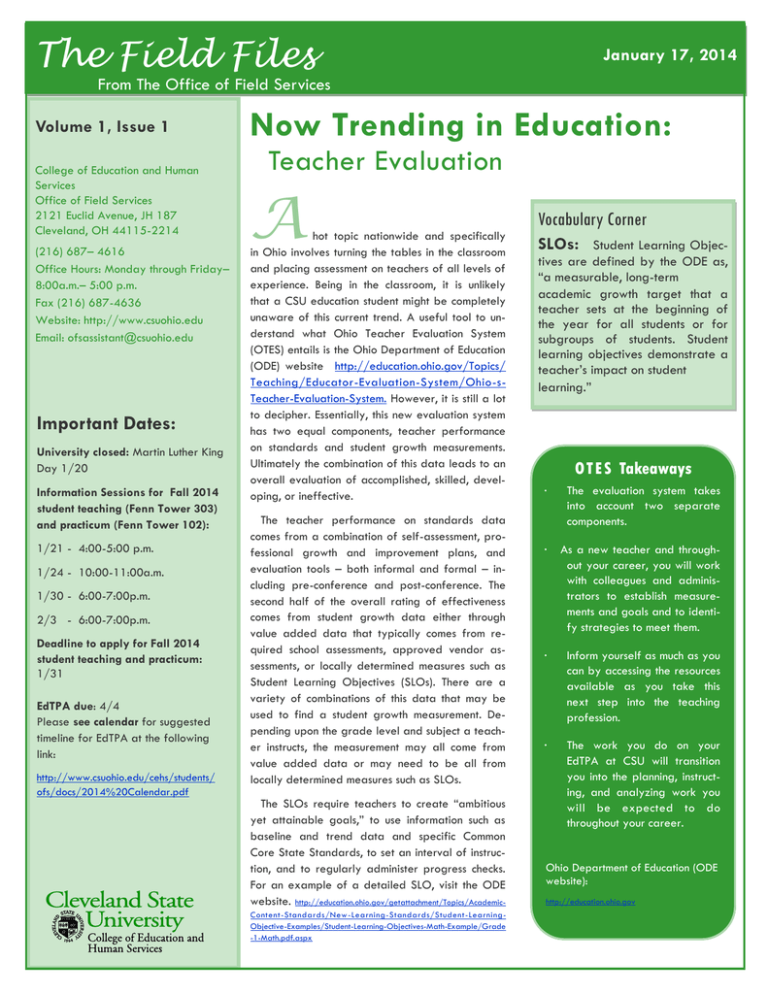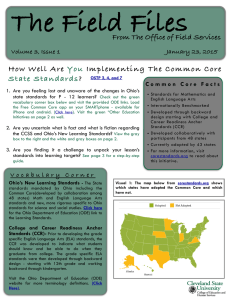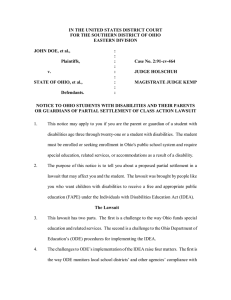Now Trending in Education: The Field Files Teacher Evaluation
advertisement

The Field Files January 17, 2014 From The Office of Field Services Volume 1, Issue 1 College of Education and Human Services Office of Field Services 2121 Euclid Avenue, JH 187 Cleveland, OH 44115-2214 (216) 687– 4616 Office Hours: Monday through Friday– 8:00a.m.– 5:00 p.m. Fax (216) 687-4636 Website: http://www.csuohio.edu Email: ofsassistant@csuohio.edu Important Dates: University closed: Martin Luther King Day 1/20 Information Sessions for Fall 2014 student teaching (Fenn Tower 303) and practicum (Fenn Tower 102): 1/21 - 4:00-5:00 p.m. 1/24 - 10:00-11:00a.m. 1/30 - 6:00-7:00p.m. 2/3 - 6:00-7:00p.m. Deadline to apply for Fall 2014 student teaching and practicum: 1/31 EdTPA due: 4/4 Please see calendar for suggested timeline for EdTPA at the following link: http://www.csuohio.edu/cehs/students/ ofs/docs/2014%20Calendar.pdf Now Trending in Education: Teacher Evaluation A hot topic nationwide and specifically in Ohio involves turning the tables in the classroom and placing assessment on teachers of all levels of experience. Being in the classroom, it is unlikely that a CSU education student might be completely unaware of this current trend. A useful tool to understand what Ohio Teacher Evaluation System (OTES) entails is the Ohio Department of Education (ODE) website http://education.ohio.gov/Topics/ Teaching/Educator-Evaluation-System/Ohio-sTeacher-Evaluation-System. However, it is still a lot to decipher. Essentially, this new evaluation system has two equal components, teacher performance on standards and student growth measurements. Ultimately the combination of this data leads to an overall evaluation of accomplished, skilled, developing, or ineffective. The teacher performance on standards data comes from a combination of self-assessment, professional growth and improvement plans, and evaluation tools – both informal and formal – including pre-conference and post-conference. The second half of the overall rating of effectiveness comes from student growth data either through value added data that typically comes from required school assessments, approved vendor assessments, or locally determined measures such as Student Learning Objectives (SLOs). There are a variety of combinations of this data that may be used to find a student growth measurement. Depending upon the grade level and subject a teacher instructs, the measurement may all come from value added data or may need to be all from locally determined measures such as SLOs. The SLOs require teachers to create “ambitious yet attainable goals,” to use information such as baseline and trend data and specific Common Core State Standards, to set an interval of instruction, and to regularly administer progress checks. For an example of a detailed SLO, visit the ODE website. http://education.ohio.gov/getattachment/Topics/AcademicContent-Standards/New-Learning-Standards/Student-LearningObjective-Examples/Student-Learning-Objectives-Math-Example/Grade -1-Math.pdf.aspx Vocabulary Corner SLOs: Student Learning Objectives are defined by the ODE as, “a measurable, long-term academic growth target that a teacher sets at the beginning of the year for all students or for subgroups of students. Student learning objectives demonstrate a teacher’s impact on student learning.” OTES Takeaways · The evaluation system takes into account two separate components. · As a new teacher and throughout your career, you will work with colleagues and administrators to establish measurements and goals and to identify strategies to meet them. · Inform yourself as much as you can by accessing the resources available as you take this next step into the teaching profession. · The work you do on your EdTPA at CSU will transition you into the planning, instructing, and analyzing work you will be expected to do throughout your career. Ohio Department of Education (ODE website): http://education.ohio.gov Volume 1, Issue 1 page 2 of 2 Best Practices: Establishing rapport, creating trust, building relationships Teaching y o u r classroom rules Individual interpretation sometimes creates confusion when it comes to classroom rules. What can you do as a classroom teacher to develop and communicate clear rules and be certain students are aware of behavioral expectations? Keep it simple! 1. Limit your classroom rules to four or five at most. 2. Make sure that you remove any ambiguity by discussing (and agreeing) with your class what the rules really mean. 3. Additionally, keep the stating of your rules positive to promote an environment focused on teaching and learning. An effective rule structure practiced by many seasoned instructors is the 4 B’s (Search “The 4 B’s classroom rules” online for thousands of examples). The simple phrasing of “Be polite, Be safe, Be kind, Be prepared” or any other “Be” that is important to your classroom is an easy way to encompass most of the laundry lists of rules an instructor might compile. Once you set and voice your rules, you cannot stop there. Why not start out your tenor as an instructor by teaching your class what your rules really mean. Remove abstract individual interpretation of rules by having small groups of students illustrate or perform an example of following and breaking each rule. Make sure to discuss how the rule was followed and how the rule was broken so that all involved parties can define what it really means to “Be Prepared”. With younger grades, it works out great to make a class contract and agree that this is the way we want our classroom community to run. It may be fun with younger or older students to allow them to add another “Be” that is personalized to your specific group. These discussions go a long way in establishing boundaries and starting to build relationships. Remember: “A rule is not a rule without a consequence.” Don’t forget to establish those too. Kids need limits and crave structure. Make sure they know what will happen if they break a rule, and then be consistent and follow through. Break the Ice! If you are feeling nervous when you take over your mentor’s classroom, remember that the students are probably nervous too. Take the time to get to know them. Choose something that is simple but will teach you about them and give you insight into what matters to them. Just like having a firm structure is important, it is also necessary to help them see that you genuinely care for them and their well-being. Check out this website for simple, effective ice breaker activities. http://www.lavc.edu/profdev/icebreakers.pdf Basic pointers: · If you are unsure of name pronunciation, have them introduce themselves and add a question you want them to answer in their introduction such as, What two items would you miss most if you were stranded on a deserted island? · Even in Ice Breaker activities, it helps kids to have an example. It is usually best for you to introduce yourself and first model whatever it is you want them to do. Certainly allow them to pass, but make sure you come back to them after they have had more time to think. · Make the students feel important. o Study their names, and say everyone’s name at least once a day – sometimes this is easiest at the door when they are walking in. o If a student is absent, remember to tell them you missed them in class — even if your class behaved better when they were absent. Final thought “The best teachers are those who become bridges to be crossed by their students. “ ~ Nikos Kazantzakis





